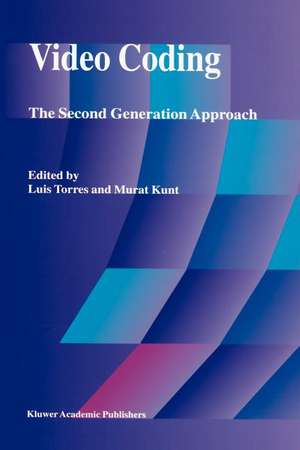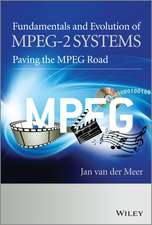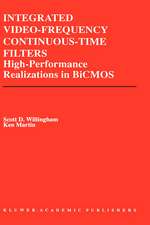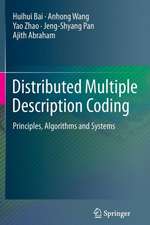Video Coding: The Second Generation Approach
Editat de Luis Torres, Murat Kunten Limba Engleză Paperback – 7 oct 2011
Second generation image and video coding techniques are the ensemble of approaches proposing new and more efficient image representations than the conventional canonical form. As a consequence, the human visual system becomes a fundamental part of the encoding/decoding chain. More insight to distinguish between first and second generation can be gained if it is noticed that image and video coding is basically carried out in two steps. First, image data are converted into a sequence of messages and, second, code words are assigned to the messages. Methods of the first generation put the emphasis on the second step, whereas methods of the second generation put it on the first step and use available results for the second step. As a result of including the human visual system, second generation can be also seen as an approach of seeing the image composed by different entities called objects. This implies that the image or sequence of images have first to be analyzed and/or segmented in order to find the entities.
It is in this context that we have selected in this book three main approaches as second generation video coding techniques:
| Toate formatele și edițiile | Preț | Express |
|---|---|---|
| Paperback (1) | 1279.20 lei 6-8 săpt. | |
| Springer Us – 7 oct 2011 | 1279.20 lei 6-8 săpt. | |
| Hardback (1) | 1285.78 lei 6-8 săpt. | |
| Springer Us – 31 ian 1996 | 1285.78 lei 6-8 săpt. |
Preț: 1279.20 lei
Preț vechi: 1599.00 lei
-20% Nou
Puncte Express: 1919
Preț estimativ în valută:
244.80€ • 254.13$ • 204.13£
244.80€ • 254.13$ • 204.13£
Carte tipărită la comandă
Livrare economică 22 martie-05 aprilie
Preluare comenzi: 021 569.72.76
Specificații
ISBN-13: 9781461285755
ISBN-10: 1461285755
Pagini: 452
Ilustrații: XIV, 434 p.
Dimensiuni: 155 x 235 x 24 mm
Greutate: 0.63 kg
Ediția:Softcover reprint of the original 1st ed. 1996
Editura: Springer Us
Colecția Springer
Locul publicării:New York, NY, United States
ISBN-10: 1461285755
Pagini: 452
Ilustrații: XIV, 434 p.
Dimensiuni: 155 x 235 x 24 mm
Greutate: 0.63 kg
Ediția:Softcover reprint of the original 1st ed. 1996
Editura: Springer Us
Colecția Springer
Locul publicării:New York, NY, United States
Public țintă
ResearchCuprins
1 Second Generation Video Coding Techniques.- 1 Introduction.- 2 The problems of the canonical representation of images.- 3 First generation video coding techniques.- 4 Second generation video coding techniques.- 5 Segmentation-based video coding results.- 6 MPEG-4 functionalities.- 7 Conclusions and new trends.- 2 Pixel-Based Video Compression Schemes.- 1 Introduction.- 2 Fundamentals of pixel-based techniques.- 3 Video coding standards.- 4 Pixel-based schemes: Properties and possible improvements.- 5 Conclusions.- 3 Coding-Oriented Segmentation of Video Sequences.- 1 Introduction.- 2 Problem statement.- 3 A general structure for segmentation.- 4 An implementation based on compound random fields.- 5 An implementation based on morphological tools.- 6 Conclusions.- 4 Coding of Partition Sequences.- 1 Introduction.- 2 Problem statement.- 3 Intra-frame coding.- 4 Inter-frame coding.- 5 Conclusions.- 5 Region-Oriented Texture Coding.- 1 Introduction.- 2 Data compression by approximation.- 3 Orthogonal basis functions for arbitrarily shaped regions.- 4 Region-oriented transform coding.- 5 Region-oriented video coding.- 6 Conclusions.- 6 Segmentation-Based Motion Estimation for Second Generation Video Coding Techniques.- 1 Introduction.- 2 Motion models.- 3 Segmentation-based fully parametric motion estimation.- 4 Spatio-temporal segmentation.- 5 Tracking.- 6 Conclusions.- 7 Fractal-Based Image and Video Coding.- 1 Introduction.- 2 Basic theory.- 3 Implementations.- 4 Conclusions.- 8 Model-Based Video Coding.- 1 Introduction: A dream in 1962.- 2 Model-based approaches to image coding.- 3 3-D model-based coding of a person’s face.- 4 2-D model-based approach using 2-D deformable triangles for advanced motion compensation.- 5 Hybrid of 3-D and 2-D model-based coding schemes.-6 Applications of 3-D model-based coding.- 9 A Perceptually Motivated Three-Component Image Model.- 1 Introduction.- 2 Psychovisual aspects of the human visual system.- 3 Characterization of strong edges.- 4 Extraction of strong edge information and the three-component image model.- 5 Coding of primary component.- 6 Coding of smooth and texture components.- 7 Image coding systems.- 8 Perceptual weighting of distortions.- 9 Video coding using the three-component image model.- 10 Conclusions.- 10 Extended Signal-Theoretic Techniques for Very Low Bit-Rate Video Coding.- 1 Introduction.- 2 Motion information.- 3 Visual perception.- 4 Signal-dependent coding.- 5 Spatio-temporal information.- 6 Acknowledgments.























